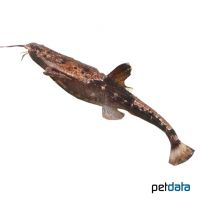Gnarled Catfish (Bunocephalus verrucosus)
| Gnarled Catfish Bunocephalus verrucosus | |
|---|---|
| Name | Gnarled Catfish |
| Name Lat. | Bunocephalus verrucosus |
| Synonym | Agmus scrabriceps |
| Family | Banjo Catfishes |
| Family lat. | Aspredinidae |
| Order | Catfishes |
| Order lat. | Siluriformes |
| Origin | South America |
| Habitat | Rivers, lakes, ponds |
| Diet | Carnivore |
| pH | 5.0-8.0 |
| Behavior | Peaceful |
| Keeping | Individual, group |
| Care Level | Moderate |
| Reproduction | Substrate spawner |
| Breeding | Difficult |
| Life Span | 5-8 years |
| Protection | No |
| Metric Units | |
| Size | 10 cm |
| Temperature | 21-26 °C |
| Hardness | 5-20 °dH |
| Aquarium | ~ 110 l |
| US Units | |
| Size | 4" |
| Temperature | 70-79 °F |
| Hardness | 89-356 ppm |
| Aquarium | ~ 30 gal |
Distribution and habitat
The range of the bighead pan catfish is the river system of the middle Amazon in Brazil. They live in the shallow waters of slow flowing and stagnant waters, such as small rivers, streams, lakes and ponds, with dense vegetation and sandy, silty bottoms, covered with dead wood, roots and leaves.
Maintenance
The aquarium should have dense planting, with shady hiding places (roots, stones) and dim light (floating plants). To be able to burrow in, they need a 5-10 cm deep, fine sandy substrate, which should be covered with some foliage, such as sea almond tree or beech leaves.
No ammonia, ammonium and nitrite should be detectable, the nitrate value should not exceed 100 mg/l. To ensure the water quality and oxygen content, a filter and heater adapted to the aquarium size is required, as well as lighting for the species-appropriate day-night rhythm of the animals.
Diet
The food supply consists of live food, such as daphnia, shrimps, earthworms, mosquito larvae or tubifex, which is also accepted without problems in frozen form, plus commercially available, frozen special food mixtures, supplemented with high-quality dry food for catfish (tablets, granules, pellets). They are nocturnal fish and should be fed only in the evening.
Regular and varied feeding promotes health and prevents deficiency symptoms. Only feed as much as is eaten overnight.
Behaviour and compatibility
They are peaceful, nocturnal fish that usually hide under roots, rocks or foliage or burrow in the sand during the day. In a community tank they can be kept well individually or in a group with other peaceful fish.
Basically, only compatible fish species with similar demands on water conditions and water temperature should be socialized
Sex dimorphism
There are no known distinguishing characteristics. Females ready to spawn can be recognized by the clearly larger girth.
Reproduction and breeding
Occasionally, breeding has been successful. They spawn in groups, with the approx. 1.2 mm large eggs being held between the pectoral fins by the female and deposited after fertilization on a suitable substrate or in a bottom depression, where they stick. The young hatch after 24-36 hours and swim freely after 4-5 days
Young fish must be fed several times a day with special rearing food (infusoria, dust food). In a community tank breeding is hardly possible, because the spawn is easy prey
Important
A powerful ejection of water through the small, slit-shaped gills allows, according to the recoil principle, a fin-independent mode of locomotion
When fishing, use nets with as fine a mesh as possible so that the hard rays of the pectoral fins do not become entangled.
The well-being of the fish should be checked regularly. Temperature should be checked daily, pH, hardness and nitrate levels at least every 14 days. Regular partial water changes are recommended, even if the contaminant level has not yet reached the upper limit. Sudden changes in water quality should be avoided. Newly introduced fish must be accustomed slowly to the water in the aquarium.
Further literature can be found in your pet store.
References
Text: petdata; Image: petdata
Source: BMELV (1998): Tierschutzgutachten - Haltung von Zierfischen (Süßwasser); RIEHL & BAENSCH (2004): Aquarien Atlas Bd. 3, Mergus Verlag; ENGELMANN (2005): Zootierhaltung - Tiere in menschlicher Obhut: Fische, Verlag Harri Deutsch
- Gemäß § 21 Abs. 5 Tierschutzgesetz idgF
